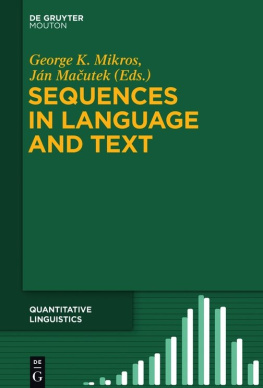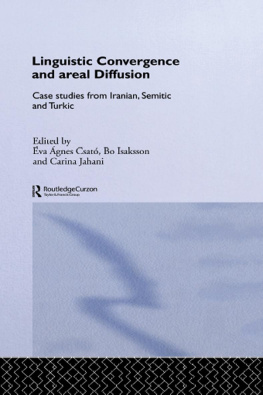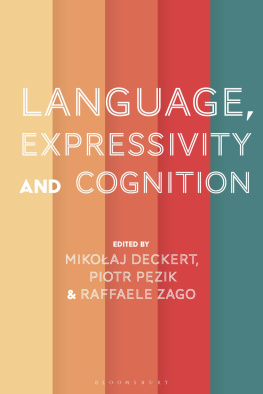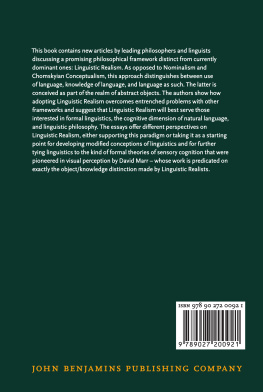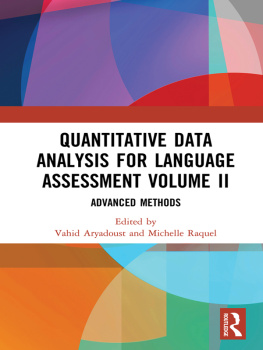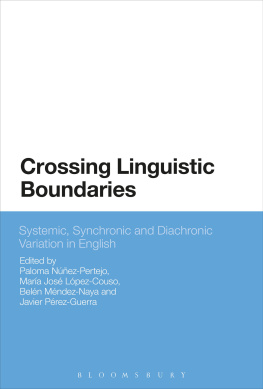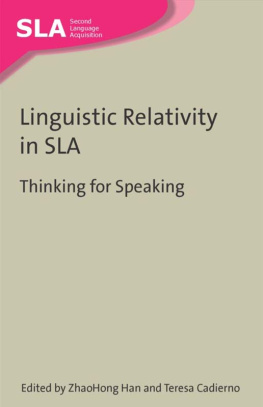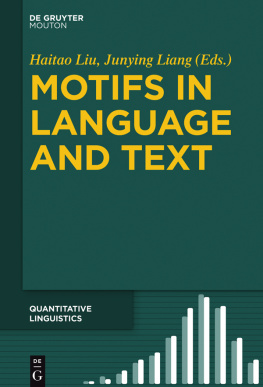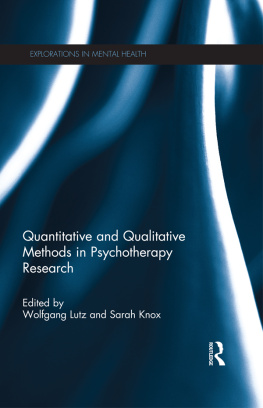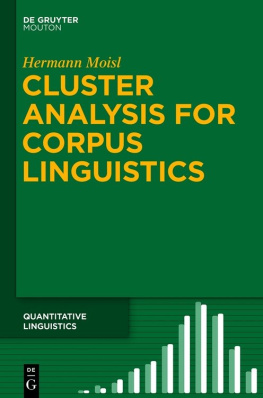George K. Mikros - Sequences in Language and Text
Here you can read online George K. Mikros - Sequences in Language and Text full text of the book (entire story) in english for free. Download pdf and epub, get meaning, cover and reviews about this ebook. year: 2015, publisher: De Gruyter, genre: Children. Description of the work, (preface) as well as reviews are available. Best literature library LitArk.com created for fans of good reading and offers a wide selection of genres:
Romance novel
Science fiction
Adventure
Detective
Science
History
Home and family
Prose
Art
Politics
Computer
Non-fiction
Religion
Business
Children
Humor
Choose a favorite category and find really read worthwhile books. Enjoy immersion in the world of imagination, feel the emotions of the characters or learn something new for yourself, make an fascinating discovery.
- Book:Sequences in Language and Text
- Author:
- Publisher:De Gruyter
- Genre:
- Year:2015
- Rating:3 / 5
- Favourites:Add to favourites
- Your mark:
- 60
- 1
- 2
- 3
- 4
- 5
Sequences in Language and Text: summary, description and annotation
We offer to read an annotation, description, summary or preface (depends on what the author of the book "Sequences in Language and Text" wrote himself). If you haven't found the necessary information about the book — write in the comments, we will try to find it.
Sequences in Language and Text — read online for free the complete book (whole text) full work
Below is the text of the book, divided by pages. System saving the place of the last page read, allows you to conveniently read the book "Sequences in Language and Text" online for free, without having to search again every time where you left off. Put a bookmark, and you can go to the page where you finished reading at any time.
Font size:
Interval:
Bookmark:
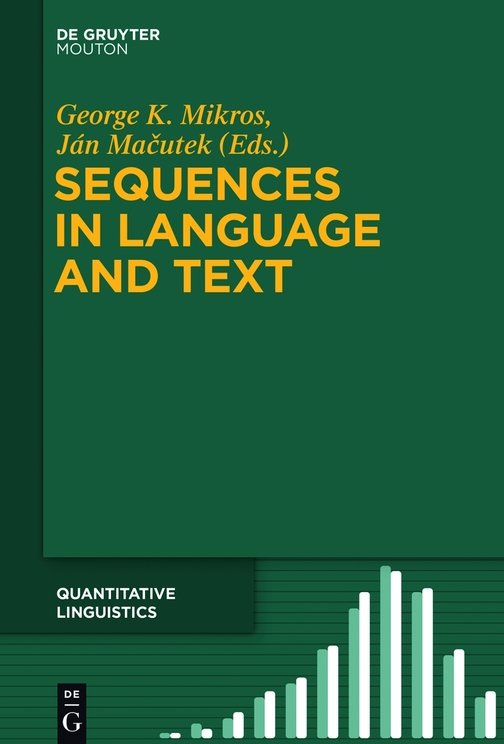
Altmann, Gabriel
Stttinghauser Ringstrasse 44, DE-58515 Ldenscheid, Germany
email: ram-verlag@t-online.de
Andreev, Sergey N.
Department of Foreign Languages
Smolensk State University
Przhevalskogo 4, RU-214000 Smolensk, Russia
email: smol.an@mail.ru
Bavaud, Franois
Department of Language and Information Sciences
University of Lausanne
CH-1015 Lausanne, Switzerland
email: francois.bavaud@unil.ch
Beneov, Martina
Department of General Linguistics
Faculty of Arts
Palacky University
Kkovskho 14, CZ-77147 Olomouc, Czech Republic
email: martina.benesova@upol.cz
Borin, Lars
Department of Swedish
University of Gteborg
Box 200, SE- 40530 Gteborg, Sweden
email: lars.borin@svenska.gu.se
Borisov, Vadim V.
Department of Computer Engineering
Smolensk Branch of National Research University Moscow Power
Engineering Institute
Energeticheskiy proezd 1, RU-214013 Smolensk, Russia
email: vbor67@mail.ru
ech, Radek
Department of Czech Language
University of Ostrava
Reln 5, CZ-77147 Ostrava, Czech Republic
email: cechradek@gmail.com
Cocco, Christelle
Department of Language and Information Sciences
University of Lausanne
CH-1015 Lausanne, Switzerland
email: christelle.cocco@alumnil.unil.ch
Eder, Maciej
Institute of Polish Studies
Pedagogical University of Krakw
ul. Podchorych 2, PL-30084 Krakw, Poland
and
Institute of Polish Language
Polish Academy of Sciences
al. Mickiewicza 31, PL-31120 Krakw, Poland
email: maciejeder@ijp-pan.krakow.pl
Khler, Reinhard
Computerlinguistik und Digital Humanities
University of Trier
FB II / Computerlinguistik, DE-54286 Trier, Germany
email: koehler@uni-trier.de
Krithara, Anastasia
Institute of Informatics and Telecommunications
National Center for Scientific Research (NCSR) Demokritos
Terma Patriarchou Grigoriou, Aghia Paraskevi, GR-15310, Athens, Greece
email: akrithara@iit.demokritos.gr
Mautek, Jn
Department of Applied Mathematics and Statistics
Comenius University
Mlynsk dolina, SK-84248 Bratislava, Slovakia
email: jmacutek@yahoo.com
Mikros, George K.
Department of Italian Language and Literature
School of Philosophy
National and Kapodistrian University of Athens
Panepistimioupoli Zografou, GR-15784 Athens, Greece
email: gmikros@gmail.com
and
Department of Applied Linguistics
College of Liberal Arts
University of Massachusetts Boston
100 Morrissey Boulevard, US-02125 Boston, MA, United States of America
email: Georgios.Mikros@umb.edu
Milika, Ji
Institute of Comparative Linguistics
Faculty of Arts
Charles University
Nm. Jana Palacha 2, CZ-11638 Praha 1
email: jiri@milicka.cz
and
Department of General Linguistics
Faculty of Arts
Palacky University
Kkovskho 14, CZ-77117 Olomouc, Czech Republic
Pawowski, Adam
University of Wrocaw
Institute of Library and Information Science
pl. Uniwersytecki 9/13, 50-137 Wrocaw, Poland
email: apawlow@uni.wroc.pl
Rentoumi, Vassiliki
SENTImedia Ltd.
86 Hazlewell road, Putney, London, SW156UR, UK
email: vassiliki.rentoumi@gmail.com
Rama K., Taraka
Department of Swedish
University of Gteborg
Box 200, SE- 40530 Gteborg, Sweden
email: taraka.rama.kasicheyanula@gu.se
Rovenchak, Andrij
Department for Theoretical Physics
Ivan Franko National University of Lviv
12 Drahomanov St., UA-79005 Lviv, Ukraine
email: andrij.rovenchak@gmail.com
Tuzzi, Arjuna
Department of Philosophy, Sociology, Education and Applied Psychology
University of Padova
via Cesarotti 10/12, IT-35123 Padova, Italy
email: arjuna.tuzzi@unipd.it
Tzanos, Nikos
SENTImedia Ltd.
86 Hazlewell road, Putney, London, SW156UR, UK
email: corelon@gmail.com
Xanthos, Aris
Department of Language and Information Sciences
University of Lausanne
CH-1015 Lausanne, Switzerland
email: aris.xanthos@unil.ch
Zrnig, Peter
Department of Statistics, Institute of Exact Sciences,
University of Braslia, 70910-900, Braslia-DF, Brazil
email: peter@unb.br
Gabriel Altmann
oscillations, cohesion, etc. This holds both for units and their conceptually constructed and measured properties, as well as for combinations of these properties which are abstractions of higher degree.
The sequential study of texts may begin with the scrutinizing of repetitions. Altmann (1988: 4f.) showed several types of repetitions some of which can be studied sequentially: (a) Runs representing uninterrupted sequences of identical elements, especially formal elements such as word-length, metric patterns, sentence types. (b) Aggregative repetitions arising from Skinners formal reinforcement which can be expressed by the distribution of distances or by a decreasing function of the number of identities. (c) The relaxing of strict identity may yield aggregative repetitions of similar entities. (d) Cyclic repetitions occurring especially in irregular rhythm, in prose rhythm, in sentence structure, etc.
Different other forms of sequences are known from text analyses. They will be studied thoroughly in the next chapters.
If we study the sequences of properties of text entities, we have an enormous field of research in our view. An entity has as many properties as we are able to discriminate at the given state of science. The number of properties increases with time, as can be seen in 150 years of linguistic research. The properties are not possessed by the entities, they do not belong to the fictive essence of entities; they are results of definitions and measurements ascribed to the entities by us. In practice, we can freely devise new properties, but not all of them need to turn out to be useful. In practise, a property is useful (reasonable) if its behaviour can be captured by an a priori hypothesis. (Usually, we proceed by trial and error, isolate conspicuous phenomena and search for a regularity inductively.) A property must display some kind of regularity, even if the regularity is a long range one. Further, it is reasonable, if it is not isolated but significantly correlated with at least some other property. This requirement makes it incorporable into a theory. A property should be element of a control cycle.
Of course, a property does not have the same sequential realization in all texts. The difference may consist in parameter values, in form modifications, resulting from the differences of text sorts, of languages, etc. But all this are only boundary conditions if we are able to set up at least an elementary theory from which we derive our models.
In order to illustrate the proliferation of properties let us consider those of the concept of word. Whatever its definition - there are several dozens - one can find a quantification and measure the following properties: (a) length measured in terms of syllable, morpheme or phoneme numbers, or in that of duration; (b) frequency in text; (c) sequences of different kind can be created in text.
At this elementary scientific level there is no hindrance to using state the mean of the property and compare the texts setting up text classes, (c) to find tendencies depending (usually) on other properties, (d) to search for idiosyncrasies; (e) to set up an empirical control cycle joining several properties, and (f) to use the sequences in practice, e.g. in psychology and psychiatry.
Though according to Bunges dictum no laws, no theory and no theory, no explanation, we may try to find at least some causes or supporting circumstances or motives or mechanisms leading to the rise of sequences. They are: (a) Restrictions of the inventories of units. The greater the restrictions (= the smaller the inventory), the more frequently a unit must be repeated. A certain sound has a stronger repetitiveness than a certain sentence because the inventory of terms etc., but hinders the use of some constructions. (d) Stylistic and aesthetic grounds which may evoke some regularities like rhyme, rhythm, but avoiding repetition of words. (e) Perseveration reinforcing repetitions, supporting self-stimulation, etc. This phenomenon is well known in psychology and psychiatry. (f) The flow of information in didactic works is ideal if words are repeated in order to concentrate the text around the main theme. In press texts the information flow is more rapid.
Font size:
Interval:
Bookmark:
Similar books «Sequences in Language and Text»
Look at similar books to Sequences in Language and Text. We have selected literature similar in name and meaning in the hope of providing readers with more options to find new, interesting, not yet read works.
Discussion, reviews of the book Sequences in Language and Text and just readers' own opinions. Leave your comments, write what you think about the work, its meaning or the main characters. Specify what exactly you liked and what you didn't like, and why you think so.

